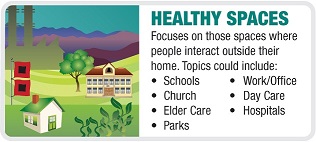Partnerships for Environmental Public Health (PEPH)

Healthy spaces focus more broadly on the non-household built environments where people live and interact (e.g., schools, parks, workplaces) and how factors intrinsic to these spaces affect human health. Designing the built environment to promote human health encompasses discrete but interactive goals, such as increasing physical activity; reducing injuries; improving air and water quality; decreasing mental health stressors; and providing fair access to livelihoods, education, and other critical social resources.


